Intel Core i9-10850K Review: The Real Intel Flagship
by Dr. Ian Cutress on January 4, 2021 9:00 AM EST- Posted in
- CPUs
- Intel
- Core
- Z490
- 10th Gen Core
- Comet Lake
- LGA1200
- i9-10850K
CPU Tests: Simulation
Simulation and Science have a lot of overlap in the benchmarking world, however for this distinction we’re separating into two segments mostly based on the utility of the resulting data. The benchmarks that fall under Science have a distinct use for the data they output – in our Simulation section, these act more like synthetics but at some level are still trying to simulate a given environment.
DigiCortex v1.35: link
DigiCortex is a pet project for the visualization of neuron and synapse activity in the brain. The software comes with a variety of benchmark modes, and we take the small benchmark which runs a 32k neuron/1.8B synapse simulation, similar to a small slug.
The results on the output are given as a fraction of whether the system can simulate in real-time, so anything above a value of one is suitable for real-time work. The benchmark offers a 'no firing synapse' mode, which in essence detects DRAM and bus speed, however we take the firing mode which adds CPU work with every firing.
The software originally shipped with a benchmark that recorded the first few cycles and output a result. So while fast multi-threaded processors this made the benchmark last less than a few seconds, slow dual-core processors could be running for almost an hour. There is also the issue of DigiCortex starting with a base neuron/synapse map in ‘off mode’, giving a high result in the first few cycles as none of the nodes are currently active. We found that the performance settles down into a steady state after a while (when the model is actively in use), so we asked the author to allow for a ‘warm-up’ phase and for the benchmark to be the average over a second sample time.
For our test, we give the benchmark 20000 cycles to warm up and then take the data over the next 10000 cycles seconds for the test – on a modern processor this takes 30 seconds and 150 seconds respectively. This is then repeated a minimum of 10 times, with the first three results rejected. Results are shown as a multiple of real-time calculation.
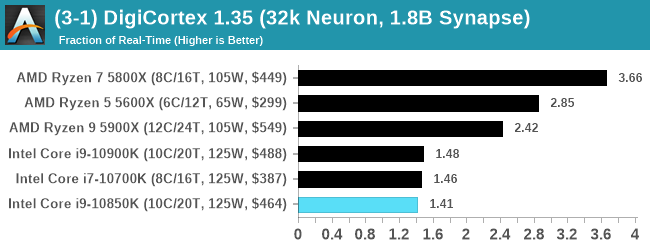
The wide variation on AMD seems to prefer high-core-count single chiplet processors. Intel is taking a back seat here, as it is also using slower memory.
Dwarf Fortress 0.44.12: Link
Another long standing request for our benchmark suite has been Dwarf Fortress, a popular management/roguelike indie video game, first launched in 2006 and still being regularly updated today, aiming for a Steam launch sometime in the future.
Emulating the ASCII interfaces of old, this title is a rather complex beast, which can generate environments subject to millennia of rule, famous faces, peasants, and key historical figures and events. The further you get into the game, depending on the size of the world, the slower it becomes as it has to simulate more famous people, more world events, and the natural way that humanoid creatures take over an environment. Like some kind of virus.
For our test we’re using DFMark. DFMark is a benchmark built by vorsgren on the Bay12Forums that gives two different modes built on DFHack: world generation and embark. These tests can be configured, but range anywhere from 3 minutes to several hours. After analyzing the test, we ended up going for three different world generation sizes:
- Small, a 65x65 world with 250 years, 10 civilizations and 4 megabeasts
- Medium, a 127x127 world with 550 years, 10 civilizations and 4 megabeasts
- Large, a 257x257 world with 550 years, 40 civilizations and 10 megabeasts
DFMark outputs the time to run any given test, so this is what we use for the output. We loop the small test for as many times possible in 10 minutes, the medium test for as many times in 30 minutes, and the large test for as many times in an hour.
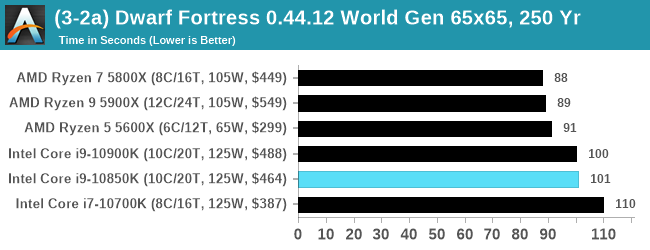
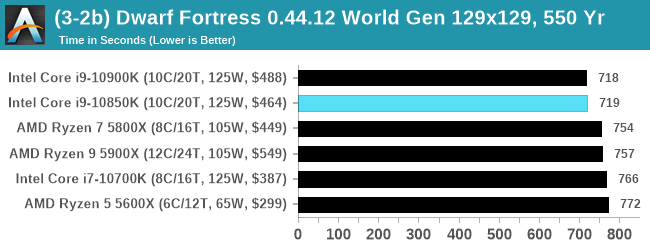
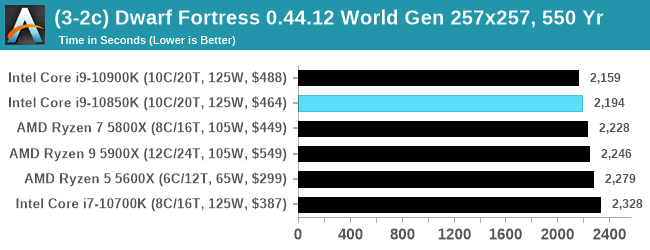
Dolphin v5.0 Emulation: Link
Many emulators are often bound by single thread CPU performance, and general reports tended to suggest that Haswell provided a significant boost to emulator performance. This benchmark runs a Wii program that ray traces a complex 3D scene inside the Dolphin Wii emulator. Performance on this benchmark is a good proxy of the speed of Dolphin CPU emulation, which is an intensive single core task using most aspects of a CPU. Results are given in seconds, where the Wii itself scores 1051 seconds.
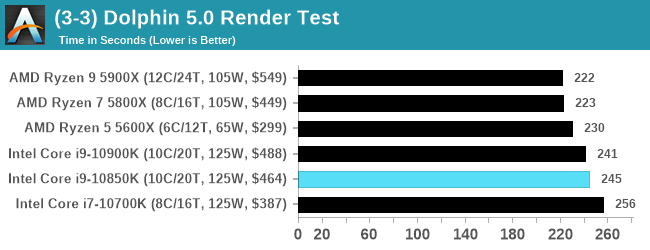












126 Comments
View All Comments
zodiacfml - Monday, January 4, 2021 - link
While it is true that AMD's current available Ryzen mobile at 7nm is superior to the M1 at 5nm, you have to consider that M1 is Apple's entry level. Things will get more interesting once AMD gets into 5nm and Apple releases bigger M1Alistair - Monday, January 4, 2021 - link
That is not true at all. Everything works on the M1, I have an M1 Mac Mini and a PC and have no problems. The issue is Apple's lack of expansion and lack of GPU performance. Games for example that are not on the Mac, not because of M1's performance (which is excellent) but because of M1's lack of GPU performance vs a basic video card, and the lack of the basic GPU expansion options. Also Mac OS sucks compared to Windows imo, but the Mac Mini hardware and M1 CPU performance are A+. Hopefully Apple doubles the GPU options and performance quickly.Meteor2 - Thursday, January 7, 2021 - link
Yes, I thought that a very strange statement too. Rosetta2 exists and it works.JayNor - Monday, January 4, 2021 - link
compared to the competition that can't respond to the WFH and educational demand?Qasar - Tuesday, January 5, 2021 - link
still better then a company that fell asleep, and stagnated the cpu industry. intels lack of innovation, and reliance on its process tech, is what has caused intel to be in the position it is now in.powerarmour - Tuesday, January 5, 2021 - link
Can you actually buy an Intel motherboard at the moment?, shortages are very apparent there too.regsEx - Thursday, January 7, 2021 - link
Apple doesn't have any high performance CPU.JessNarmo - Monday, January 4, 2021 - link
420mm AIO with bare die liquid metal here we come!But jokes aside good 360 AIO with liquid metal should keep it quite easily under 80C at all times.
Anytime you see significant temperatures liquid metal helps disproportionately more, because it's thermal conductivity grows with temperature unlike thermal pastes. It drops 20C from 80C on paste and 30C from 100C on paste.
Still I'd rather wait for 5900x
Deicidium369 - Monday, January 4, 2021 - link
Did you see the cooler?http://thermalright.com/product/true-copper/
passive design
lopri - Monday, January 4, 2021 - link
I have been looking for that cooler. Does anyone know where to find one?